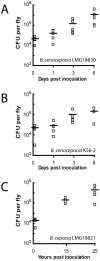Drosophila melanogaster as a model host for the Burkholderia cepacia complex
- PMID: 20635002
- PMCID: PMC2902503
- DOI: 10.1371/journal.pone.0011467
Drosophila melanogaster as a model host for the Burkholderia cepacia complex
Abstract
Background: Colonization with bacterial species from the Burkholderia cepacia complex (Bcc) is associated with fast health decline among individuals with cystic fibrosis. In order to investigate the virulence of the Bcc, several alternative infection models have been developed. To this end, the fruit fly is increasingly used as surrogate host, and its validity to enhance our understanding of host-pathogen relationships has been demonstrated with a variety of microorganisms. Moreover, its relevance as a suitable alternative to mammalian hosts has been confirmed with vertebrate organisms.
Methodology/principal findings: The aim of this study was to establish Drosophila melanogaster as a surrogate host for species from the Bcc. While the feeding method proved unsuccessful at killing the flies, the pricking technique did generate mortality within the populations. Results obtained with the fruit fly model are comparable with results obtained using mammalian infection models. Furthermore, validity of the Drosophila infection model was confirmed with B. cenocepacia K56-2 mutants known to be less virulent in murine hosts or in other alternative models. Competitive index (CI) analyses were also performed using the fruit fly as host. Results of CI experiments agree with those obtained with mammalian models.
Conclusions/significance: We conclude that Drosophila is a useful alternative infection model for Bcc and that fly pricking assays and competition indices are two complementary methods for virulence testing. Moreover, CI results indicate that this method is more sensitive than mortality tests.
Conflict of interest statement
Figures






References
-
- Burkholder W. Sour skin, a bacterial rot of onion bulbs. Phytopathology. 1950;64:468–475.
-
- Chiarini L, Bevivino A, Dalmastri C, Tabacchioni S, Visca P. Burkholderia cepacia complex species: health hazards and biotechnological potential. Trends Microbiol. 2006;14:277–286. - PubMed
-
- Vial L, Groleau MC, Dekimpe V, Déziel E. Burkholderia diversity and versatility: an inventory of the extracellular products. J Microbiol Biotechnol. 2007;17:1407–1429. - PubMed
-
- Aaron SD, Ferris W, Henry DA, Speert DP, Macdonald NE. Multiple combination bactericidal antibiotic testing for patients with cystic fibrosis infected with Burkholderia cepacia. Am J Respir Crit Care Med. 2000;161:1206–1212. - PubMed
Publication types
MeSH terms
Grants and funding
LinkOut - more resources
Full Text Sources
Other Literature Sources
Molecular Biology Databases

